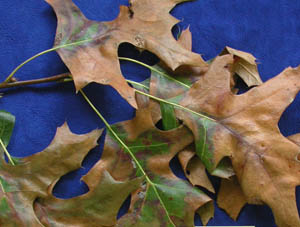Bacterial Leaf Scorch Testing Time | |
|---|---|
| August 13, 2007 | |
|
Here is a disease that you really ought to learn about if you are in the tree-care business. About midsummer, infected trees appear to have environmental leaf scorch. The same trees appear healthy again the next spring, but scorching returns each summer, becoming progressively worse over 5 or 6 years until the tree dies. The disease can kill mature trees. Bacterial leaf scorch (BLS) is an infectious plant disease caused by a bacterium, Xylella fastidiosa. The pathogen is systemic, living in the xylem. The most frequent U.S. hosts include elm, oak, sycamore, mulberry, sweetgum, sugar maple, and red maple. In Illinois, we have identified the problem on oak. At the U of I Plant Clinic, we have confirmed it on pin, red, shingle, bur, and white oaks. Kentucky reports BLS on pin, red, scarlet, bur, white, willow, and shingle oaks; silver, sugar, and red maples; sweetgum, sycamore, planetree, hackberry, American elm, and red mulberry. Look for scorch symptoms that occur in early summer to midsummer, intensifying in late summer. The scorched leaf edges or tissue between veins may be bordered by a yellow or reddish brown color, but not in all cases. Symptoms occur first on one branch or section of branches and slowly spread in the tree from year to year. It is one of those situations that you hope will be better but gets worse. The image shows an Illinois pin oak with BLS.  There is no cure. Some have tried injections with oxytetracycline, but none have shown more than disease suppression with this antibiotic. Because the pathogen is in the xylem, cleaning pruning tools before moving to another tree is important to reduce spread of the disease. Xylem-feeding leafhoppers and spittlebugs are thought to spread the bacterium in landscape trees. It can also be transmitted between trees through root grafts. The bacterial pathogen cannot be isolated in the lab as most other bacteria. It can be confirmed using serological techniques. ELISA (enzyme-linked serological assay) testing can be done in a day and is used to help identify the Xylella pathogen. The most reliable test results occur in August and September, possibly because the bacterial population in the tree is higher. The U of I Plant Clinic will test for this bacterial pathogen the week of August 20. If you have a sample you want tested for BLS, and you live in the state of Illinois, call (217)333-0519, and we will arrange to run an ELISA with the next batch of samples. It is not economical to run this test for only one sample, but the standard $12.50 Plant Clinic fee covers expenses when multiple samples are processed together. Testing for Xylella fastidiosa is done on new growth. Send 3 inches of twig tip and all leaves attached to it. Place three or four such tip cuttings in a zip-lock bag, label with the tree species, include a check ($12.50) payable to the University of Illinois and a completed specimen data form (http://plantclinic.cropsci.uiuc.edu/hortdf.pdf), and mail to the Plant Clinic (http://plantclinic.cropsci.uiuc.edu/). We can accept only Illinois samples at this time. �� | |
| Author: | Nancy Pataky |
